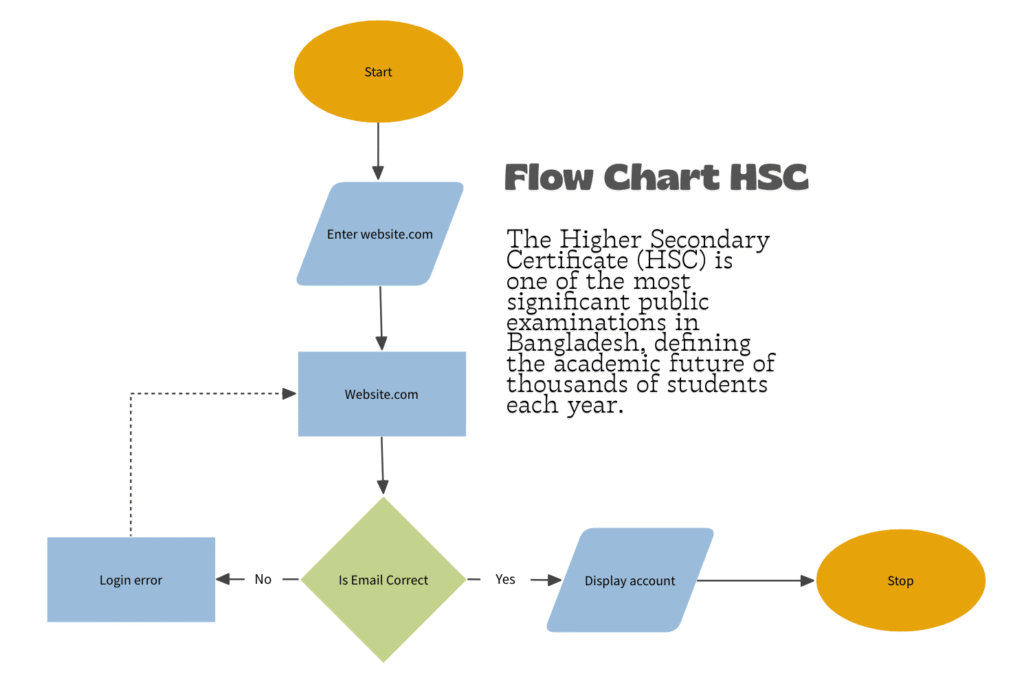The Higher Secondary Certificate (HSC) is one of the most significant public examinations in Bangladesh, defining the academic future of thousands of students each year. Among the various types of questions in the HSC English First Paper, one of the most important and scoring sections is the Flow Chart HSC question. Many students think the flow chart HSC question is easy because it looks like simple boxes and arrows, but in truth, it evaluates analytical ability, comprehension, and clarity of expression. A perfectly drawn flow chart HSC answer demonstrates how efficiently a student can convert a long paragraph into short, meaningful, and logically connected visual ideas. Although the flow chart HSC question carries only a few marks, it can make a big difference in a student’s overall score when answered correctly and neatly.
What is Flow Chart HSC?
A flow chart HSC question in English is a visual representation of information from a passage. It shows the logical sequence of events, processes, or actions in a clear, diagrammatic form. Usually, the exam question asks students to “read the passage and make a flow chart showing the main activities of…” or “make a flow chart showing the stages of…”. The purpose of the flow chart HSC question is to test how well students can identify the main ideas and arrange them in the correct order.
Each box in a flow chart HSC represents one main point, and arrows between boxes indicate the flow or direction of the ideas. For instance, if the passage is about a famous scientist, the flow chart may look like this: Early Life → Education → Discoveries → Achievements → Recognition → Legacy. This simple diagram summarizes an entire passage visually and logically. The flow chart HSC question doesn’t need full sentences; short, accurate phrases are enough. This visual summary shows both comprehension and creativity—two essential qualities for success in English writing.
Flow Chart HSC – Quick Bio Overview
| Category | Details |
|---|---|
| Full Title | Flow Chart HSC (Higher Secondary Certificate English Component) |
| Exam Type | HSC English First Paper |
| Primary Focus | Summarizing information visually through boxes and arrows |
| Total Marks | Usually 5 marks (varies by question pattern) |
| Introduced In | Part of the HSC English syllabus under creative writing |
| Main Objective | To test analytical, summarizing, and organizational skills |
| Difficulty Level | Easy to moderate |
| Average Preparation Time | 10–15 minutes per question |
| Common Topics | Biographies, social issues, moral lessons, environment, history |
| Best Practice Tip | Read carefully, pick six main ideas, and keep layout neat |
| Updated Exam Format | Revised in recent years to include more diverse topics |
| Ideal For | Students aiming for full marks in short-answer sections |
| Recommended Resources | Skylark Education, EngExercise, YouTube educational channels |
| Marking Criteria | Relevance, logical order, neatness, and correctness of ideas |
| Scoring Potential | Very high if formatted and written correctly |
Why Flow Chart HSC is Important
The flow chart HSC question plays a crucial role in testing a student’s reading and analytical skills. It measures how effectively a student can extract the most important information from a passage and present it in a concise way. It also evaluates organization and sequence, two vital aspects of logical thinking. A well-prepared student can transform a dense text into an easy-to-follow flow chart HSC, showing a clear understanding of content structure.
From an examiner’s perspective, a flow chart HSC answer provides an instant overview of a student’s grasp of the text. Unlike long descriptive answers, it is quick to check and score. For students, it’s a golden opportunity to earn full marks with minimal writing if they follow the rules correctly. The flow chart HSC question also helps improve summarization skills, which are valuable for academic writing, presentations, and even professional communication later in life.

Rules and Structure of Flow Chart HSC
To earn full marks in flow chart HSC, students must follow certain rules. The first rule is that every flow chart should have a clear and relevant title written above the boxes—for example, “A Flow Chart Showing the Life of Begum Rokeya” or “A Flow Chart Showing the Benefits of Reading Books.”
The second rule is to maintain exactly six boxes in your flow chart HSC answer, including any that might be given in the question. The boxes can be arranged horizontally or vertically, but they must be evenly sized and neatly aligned.
The third rule concerns direction—arrows should connect all boxes to show the step-by-step flow of ideas. Missing arrows or disconnected boxes reduce marks. The fourth rule is that each box should contain a short phrase or key idea, not full sentences. For example, instead of writing “He started working for equality,” it’s better to write “Working for equality.”
The fifth rule: never use punctuation like commas or full stops inside the boxes. Each box is an independent point, not a sentence. Lastly, neatness matters—an examiner appreciates when your flow chart HSC is clean, straight, and evenly spaced. A professional presentation can earn you the full score even if your phrasing is simple.
Language Patterns for Flow Chart HSC
Writing short and grammatically correct phrases is the secret to mastering flow chart HSC answers. Teachers recommend a few standard language patterns:
- Verb + ing + noun pattern, e.g., Helping poor people, Improving education system.
- To + verb form, e.g., To achieve equality, To promote awareness.
- By + verb + ing structure, e.g., By leading a movement, By inspiring others.
- Past participle forms, e.g., Founded organization, Established school.
- Being + adjective/noun form, e.g., Being courageous, Being honored.
These patterns make your flow chart HSC answers sound natural and precise while keeping them short enough to fit neatly into boxes.
Example of Flow Chart HSC
Here’s a simple example of a flow chart HSC based on the topic “The Benefits of Meditation.”
Reducing stress → Improving concentration → Developing emotional balance → Enhancing creativity → Promoting health → Achieving peace of mind.
Each box contains a short and meaningful phrase. The sequence flows logically, showing the gradual process of benefit. This example perfectly illustrates how to present an answer in the chart HSC section—simple, accurate, and well-structured.
Benefits of Practicing Flow Chart HSC
Practicing flow chart HSC regularly helps students beyond the exam hall. The biggest advantage is simplifying complex information. When students convert a long passage into boxes and arrows, they learn to identify core ideas and eliminate unnecessary words. This process also improves memory and recall, as visuals are easier for the brain to remember than plain text.
The chart HSC format trains students to think logically. Deciding which idea comes first, what follows next, and how it concludes encourages analytical order. In real exams, it also saves time—an experienced student can draw and complete a full chart HSC in less than ten minutes, leaving more time for essays and grammar questions. Another reason to practice flow charts is that they are high-scoring. Examiners prefer short, structured answers that show clear understanding. A neat, logical chart HSC earns full marks consistently.
Recent Changes and Updates in Flow Chart HSC
In recent years, there have been noticeable updates in the flow chart HSC question pattern. Earlier, flow charts mainly appeared in passages related to biographies or moral stories. However, recent HSC exams have expanded topics to include environmental issues, technological innovation, health awareness, and global progress. This variety encourages students to study a wide range of materials.
Another change is in presentation requirements. Modern examiners emphasize neatness and consistency. A student may lose marks if boxes are uneven or if arrows don’t connect properly. Teachers now advise students to practice both horizontal and vertical flow chart HSC layouts, as both are acceptable if the sequence is clear.
Online learning has also made a big impact. Websites such as Skylark Education and EngExercise publish examples, model questions, and downloadable flow chart HSC PDFs. Students can now watch video tutorials and learn advanced formatting techniques. These modern resources make preparing for chart HSC easier, more engaging, and more effective than before.
Tips to Master Flow Chart HSC
To master the flow chart HSC question, students need both conceptual understanding and regular practice. Begin by reading the passage carefully and identifying six key ideas or actions. Then, write each idea as a short, simple phrase. Before drawing, sketch the structure in pencil to ensure alignment. Start with a title, then draw boxes, connect them with arrows, and finally write your summarized ideas.
After completing the chart HSC, double-check for any missing arrows, spelling mistakes, or long sentences. Daily practice with different types of passages helps develop speed and precision. Keep a small notebook for your chart HSC exercises—it becomes an excellent resource during revision time. Remember, neat presentation, clear handwriting, and logical order together ensure high marks.
Final Thoughts on Flow Chart HSC
The flow chart HSC question might seem like a small part of the English paper, but its educational value is huge. It reflects how well a student can read, analyze, and represent information in a structured format. The chart HSC improves clarity, organization, and logical thinking—qualities that are valuable in both academic and professional life.
When students master flow chart HSC techniques, they not only secure easy marks but also develop strong summarization skills. A good chart HSC is like a mirror of understanding—it shows both knowledge and creativity. Therefore, students should treat it as a serious scoring opportunity. Practice regularly, follow the rules, and keep your diagrams clean and consistent. With the right effort, anyone can achieve full marks in this section and stand out in the HSC English examination. Remember, in education, clarity means power—and nothing demonstrates clarity better than a well-designed chart HSC.
FAQs
1. What is the purpose of this question in the English exam?
It checks a student’s ability to summarize and organize information visually. This question helps teachers see how clearly students understand a passage.
2. How many boxes should be used in the answer?
Typically, six boxes are required, including any already given in the question. Keeping the number consistent ensures full marks.
3. Can I write full sentences inside the boxes?
No, only short phrases or main ideas should be written. Long sentences make the diagram cluttered and may reduce marks.
4. Are arrows necessary between the boxes?
Yes, arrows show the correct sequence and connection between ideas. Missing arrows can make the answer incomplete.
5. How can I improve my presentation for this question?
Keep all boxes even, use clean handwriting, and maintain equal spacing. A neat and well-structured layout always impresses examiners.


